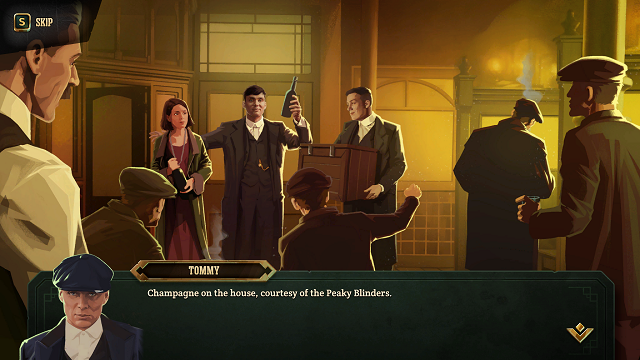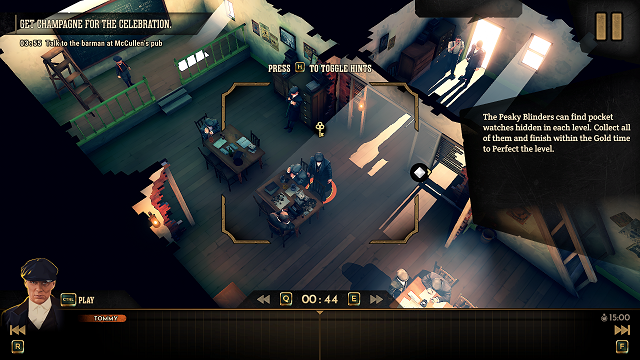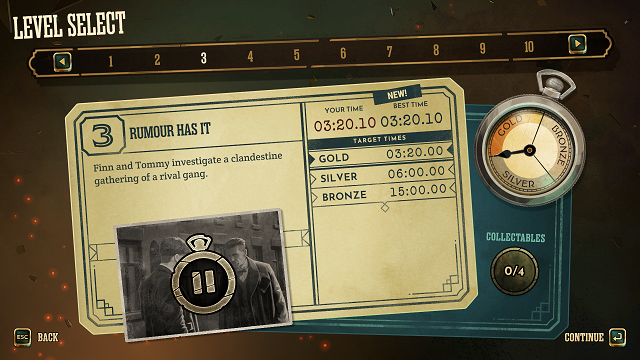Contrary to my self-proclaimed tea-drinking, crumpet-eating ways, I was a Brit that hadn’t seen a single episode of the award-winning British crime series, Peaky Blinders, when a copy of Peaky Blinders: Mastermind was dropped into my lap.
Despite its popularity and success, the show was never something that particularly grabbed my attention, and while Peaky Blinders: Mastermind was, unfortunately, unable to capture it for long, it did at least “peak“ my interest in the show.
Peaky Blinders: Mastermind Review — Hop It!

Peaky Blinders: Mastermind opens somewhat confusingly, jumping directly into a conversation between members of the Shelby family without establishing the setting, characters, or timeline. Without any context from the series, it’s unclear that this is actually a prequel to the show, detailing how Tommy Shelby (Cillian Murphy in the TV series) came to be the leader of the titular Birmingham gang.
The core gameplay loop of Peaky Blinders: Mastermind puts you in simultaneous control of Shelby family members as they distract guards, beat up thugs, steal from rival gangs, and generally sow discord on the streets of Birmingham.
To do this successfully, you need to grab the game’s timeline by the horns and wrestle it to your will, synchronizing actions together to slip through gaps in a patrol route or pull two levers at the same second to open an important door.
Actually, for 1920s Birmingham, there are a lot of lever-controlled doors…
While the idea of scrubbing through a timeline to sync up actions or tinker with a character’s path was the hook that drew me into Peaky Blinders: Mastermind, it’s regrettably a bit of a one-hit-wonder.
Though the fairly basic movement puzzles definitely ramp up in their complexity as the game progresses, everything from fighting thugs to distracting guards to kicking down doors is achieved with a single press of a button — the same “action” button.
This leaves the gameplay feeling much more methodical than I feel it needed to be — simple mini-games for the various actions would have gone a long way towards providing some variance. Instead, every obstacle boils down to a “press ‘A’ here” prompt that isn’t satisfying or rewarding to complete.

Speaking of missed opportunities, the characters in Peaky Blinders: Mastermind are mere shells of their series adaptations. I’ve now watched a couple of episodes of Peaky Blinders on Netflix, and the difference between the two products is night and day.
Tommy’s PTSD is featured in one level but with none of the backstory that we see in the show that makes it poignant, and Aunt Polly’s character is only a fraction of the bad-ass caretaker that she should be in Mastermind.
Without voice acting it is difficult to do these characters justice, but there just isn’t enough depth to the dialogue to make them relatable.
Two things Peaky Blinders: Mastermind does nail, however, are its visuals and score.
The story beats have a simplified brush-stroke aesthetic that’s downright gorgeous, while the in-game environments, models, and animations are all pleasant to look at from your isometric perspective.
Peaky Blinders: Mastermind also features an original score from Feverist, the band behind the iconic soundtrack of Peaky Blinders season one. It’s instantly familiar to fans of the series, while also being thematic and broody enough to feel appropriate to complete newcomers.

Our short foray into the land of positives must come to an abrupt end, however, as I’ve yet to mention the game’s controls. The keyboard controls for Peaky Blinders: Mastermind are an exhausting, infuriating mess.
The game was clearly designed with controllers in mind — a point which it stresses when you boot up the title — so I can’t berate it too much, but suffice to say that I wouldn’t recommend you go anywhere near Mastermind without a controller.
Once I switched to a controller, some aspects improved instantly, but the most aggravating problem — rewriting actions — sadly did not.
For a game centered around a timeline feature and rewinding time to change or synchronize actions, Peaky Blinders: Mastermind has the horrendous habit of not letting you take control of a character when you want to.
After multiple hours and hundreds of attempts, I’m still not entirely sure what the trigger is for actually being able to rewrite an action on the timeline, as the game seems to arbitrarily block you from taking control half of the time, no matter what button you press.
This general jankiness with the controls really puts a huge damper on what is otherwise a short yet robust puzzler. When coupled with the lack of an interesting opening and poor character adaptation, though, this title gets harder and harder to recommend.
Peaky Blinders: Mastermind Review — The Bottom Line

Pros
- Interesting puzzling nature thanks to the timeline mechanic
- Amazing aesthetic is true to the series
Cons
- Flat adaptations of the characters
- Frustrating controls
- Lack of substance
With only 10 missions and a small smattering of collectibles, there really isn’t any replay value present in this short affair, which only reinforces the feeling that this title is severely lacking depth.
You can replay missions to try and improve your times, and the windows to achieve a Gold ranking on each are often as thin as the razors in Tommy’s cap, but I had no urge to return once the credits rolled.
It’s a real shame that Mastermind fails to capitalize on the evocative theme and characters of the Peaky Blinders canon. Even as someone who hasn’t finished the first of its five seasons, I can already tell what a missed opportunity Mastermind is.
[Note: Curve Digital provided the copy of Peaky Blinders: Mastermind used for this review.]







Published: Aug 18, 2020 12:46 pm